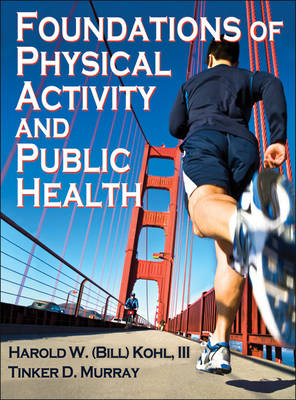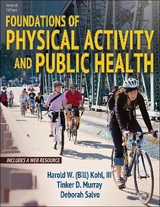
Foundations of Physical Activity and Public Health
Human Kinetics (Verlag)
978-0-7360-8710-0 (ISBN)
- Titel erscheint in neuer Auflage
- Artikel merken
Foundations of Physical Activity and Public Health is the first textbook to clearly define the intersection of kinesiology and public health. Authors Kohl and Murray, both leaders in the field, offer a solid introduction to the concepts of public health and kinesiology, the techniques used to measure physical activity, and the health effects of exercise and physical activity. The scientific findings and applications that led to the emergence of the field of physical activity and public health are also examined. Students will come away with a greater understanding of how experts from both fields can work together to advance the use of physical activity for the prevention and treatment of chronic disease and other health issues.
Foundations of Physical Activity and Public Health describes how physical activity improves health, including cardiorespiratory and metabolic diseases, overweight and obesity, musculoskeletal disorders, cancers, and mental health. Data on the prevalence and economic costs are presented to demonstrate the scope of the health issues and the importance of addressing them. Information on common testing methods, evidence on the benefits of physical activity, and recommendations for physical activity will give readers the background knowledge for promoting physical activity as a means of improving health. The health risks associated with physical activity are also discussed. Information on the prevalence of problems, the adaptive processes that can help prevent injury, and minimizing risks will prepare students to consider and address safety concerns.
The text examines evidence-based strategies for increasing physical activity in individuals and populations using three general approaches: informational, behavioral and social, and environmental and policy. Examples of successful programs from various settings, including community-wide and school-based interventions, help students understand how to apply the theory to practice. Students also learn the concepts of evaluation of physical activity programs as well as logic models, evaluation designs, data collection, and analysis. In addition, building effective partnerships for physical activity programs is discussed alongside real-world initiatives such as the state plan Active Texas 2020, the U.S. National Physical Activity Plan, and the Toronto Charter for Physical Activity. Strategies and models for physical activity advocacy are also addressed.
The text features a wealth of pedagogical aids that will enhance students’ learning experience. Chapter-opening summaries and question lists detail key concepts to focus on, case studies and callout boxes provide real-world examples that tie theory to practice, and Key Leader Profile sidebars allow students to explore career options while learning more about individuals who have had a major impact on this emerging field. Each chapter ends with a review of the most important ideas covered, key terms, and study questions that will help students test their recall and develop their understanding of the material. Full bibliographies are provided as well as valuable online resource lists in the E-Media sections. For instructors, ancillaries are available to assist in teaching their courses.
Foundations of Physical Activity and Public Health is also an asset to new professionals as well as those preparing for the ACSM/NPAS Physical Activity in Public Health Specialist certification exam. The text addresses the core competencies put forth by NPAS—including partnership development, planning and evaluation, development of effective interventions, and evaluation of scientific data—and is cross-referenced at the end of each chapter for easy review.
As the emphasis on physical activity as a tool for improving public health grows, the expertise of professionals with the combined knowledge and skills from both the public health science and exercise science fields will be highly sought. Foundations of Physical Activity and Public Health will help students obtain an overview of the kinesiology and public health areas, understand physical activity applications for public health, learn about career options, and inspire them to choose a career in the emerging field of physical activity and public health.
Harold W. (Bill) Kohl, III, PhD, is a professor of epidemiology and kinesiology at the University of Texas School of Public Health Austin Regional Campus and the University of Texas at Austin. Before this appointment, he served as lead epidemiologist and team leader in the Physical Activity and Health Branch of the Division of Nutrition and Physical Activity at the Centers for Disease Control and Prevention in Atlanta. He has worked since 1984 in the area of physical activity and health, including conducting research, developing and evaluating intervention programs for adults and children, and developing and advising on policy issues. He earned his doctorate in epidemiology and community health studies at the University of Texas Houston Health Science Center School of Public Health and a master’s of science degree in public health at the University of South Carolina. Kohl’s other areas of specialization are biostatistics and health promotion. His research interests include current focuses on physical activity, exercise, fitness and health, and sports medicine surveillance systems for musculoskeletal injuries. In his recent efforts, he has concentrated on national and international physical activity surveillance and epidemiology issues as well as program development and evaluation studies for the promotion of school-based physical activity for children and adolescents. Kohl has served as an elected trustee and is a fellow of the American College of Sports Medicine and is a fellow in the National Academy of Kinesiology. He is the founding president of the International Society for Physical Activity and Health. He has served in an editorial capacity for several scientific journals and is currently coeditor of the Journal of Physical Activity and Health. He has published more than 150 articles, chapters, and monographs in the scientific literature. Tinker D. Murray, PhD, is a professor of health and human performance at Texas State University in San Marcos. He earned his PhD in physical education from Texas A&M University in 1984. His research interests include school-based and clinical-based youth physical activity interventions for the prevention of obesity and diabetes, continuing education opportunities for coaching education, and personal fitness and training applications related to exercise physiology. From 1982 to 1984, Murray served as director of cardiac rehabilitation at Brooke Army Medical Center, where he was twice recognized for his exceptional performance. Since 1984, he has been at Southwest Texas and Texas State University, where he served as the director of employee wellness from 1984 to 1988 and director of the exercise performance laboratory from 1984 to 2000. He was a volunteer assistant cross country and track coach at Southwest Texas from 1985 to 1988 and helped win three Gulf Star Conference titles. From 1985 to 1988, he was a subcommittee member for the Governor's Commission on Physical Fitness that developed the Fit Youth Today Program. He served as lecturer and examiner for the USA Track and Field Level II Coaching Certification Program from 1988 to 2008 and as the vice chair of the Governor's Commission for Physical Fitness in Texas from 1993 to 1994. He has worked with the Texas High School Coaches Association (THSCA) since 2003 as a facilitator with the Professional Development Cooperative, which promotes continuing education opportunities. Murray is a fellow of the American College of Sports Medicine (ACSM) and certified as an ACSM program director. He was a two-time president of the Texas regional chapter of ACSM (1987 and 1994). He served on the national ACSM Board of Trustees from 1998 to 2001. In the fall of 2003, he was a guest researcher at the Centers for Disease Control and Prevention (CDC) Division of Nutrition and Physical Activity. He has been a member of the International Society for Physical Activity and Health (ISPAH) since 2009 and has attended all three biannual meetings of the International Congress on Physical Activity and Public Health.
Part I. Introduction to Physical Activity and Public Health
Chapter 1. Fundamentals of Public Health
Defining Moments in Public Health
Areas of Specialization in Public Health
Core Functions of Public Health
Public Health Law
Chapter 2. Fundamentals of Kinesiology
Kinesiology Disciplines and Exercise Training
Principles of Exercise Training, Prescription, and Planning
Applying Physical Activity and Exercise Training Principles
Chapter 3. Integrating Public Health and Physical Activity
History of Physical Activity and Public Health
Role of Physical Activity in Chronic Disease Development
From Science to Practice and Back
Promoting Physical Activity for Health
Practitioners of Physical Activity in Public Health
Chapter 4. Measuring Physical Activity
Importance of Fitness Assessments
Caloric Expenditure Measures
Electronic Measures of Energy Expenditure
Direct Observation Techniques
Self-Report Instruments
Surveillance in Populations
Part II. The Health Effects of Exercise and Physical Activity
Chapter 5. Cardiorespiratory and Metabolic Health
Prevalence of Cardiovascular Disease
Risk Factors for Cardiovascular Disease
Kinesiology and Cardiorespiratory Health
Cardiorespiratory Fitness Assessments
General Recommendations for Cardiorespiratory Health
Prevalence of Metabolic Disease
Metabolic Disease Risk Factors
Kinesiology and Metabolic Health
Common Tests of Metabolic Function
Fitness Recommendations for Metabolic Health
Chapter 6. Overweight and Obesity
Caloric Balance
Prevalence of Obesity and Overweight and Associate Health Consequences
Obesity and Overweight Risk Factors
Obesity and Overweight Challenges
Kinesiology and Body Weight
Common Assessments of Obesity and Overweight
Physical Activity Guidelines for a Healthy Weight
Chapter 7. Musculoskeletal and Functional Health
Prevalence of Musculoskeletal Disorders and Related Health Challenges
Risk Factors Associated with Musculoskeletal Disorders and Associate Health Challenges
Kinesiology and Musculoskeletal Health
Common Tests of Musculoskeletal Fitness or Function
Physical Activity and Musculoskeletal Health
Functional Health
Risk Factors for Poor Functional Health
Common Tests of Functional Health
Fitness Recommendations for Functional Health
Chapter 8. Cancers
Prevalence of Cancers
Cancer Risk Factors
Kinesiology and Cancers
Physical Activity Among Cancer Survivors
Physical Activity Guidelines for Cancer Prevention
Chapter 9. Mental Health
Prevalence and Economic Costs of Mental Health Disorders Common Mental Health Disorders
Risk Factors Associated With Mental Health Disorders
Physical Activity, Exercise, and Mental Health
Exercise, Physical Activity, and Brain Function
Physical Activity Guidelines for Mental Health
Chapter 10. Health Risks of Exercise and Physical Activity
Musculoskeletal Injuries
Exercise-Related Sudden Cardiac Death
Part III. Approaches for Effective Physical Activity Promotion
Chapter 11. Informational Approaches for Promoting Physical Activity
Understanding the Community Guide
Rationale for Informational Approaches
Chapter 12. School-Based Approaches to Promoting Physical Activity
Rationale for School-Based Physical Activity Interventions
Kinesiology and Physical Activity Outcomes for Youth
School-Based Physical Activity and Physical Fitness Assessments of Youth
Physical Activity in Children and Adolescents
Public School Physical Education
Developmental Considerations for Physical Activity in Youth
Chapter 13. Behavioral and Social Approaches to Promoting Physical Activity
Behavioral Theories and Theoretical Models of Behavior Change
Social Support for Health Behavior Change
Individually Adapted Health Behavior Change Programs
Social Support Interventions in Community Settings
Chapter 14. Environmental and Policy Approaches to Promoting Physical Activity
Access
Urban Design and Land Use Policies
Measuring the Built and Physical Environment
Chapter 15. Physical Activity and Public Health Program and Policy Evaluation
Ways to Measure Program and Policy Effectiveness
Logic Models for Physical Activity Promotion and Policies
Evaluation Designs
Data Collection and Analysis
Publishing and Communicating Results
Chapter 16. Partnership Development and Advocacy
Key Factors in Building Partnerships
Strategies for Physical Activity Advocacy
| Verlagsort | Champaign, IL |
|---|---|
| Sprache | englisch |
| Maße | 216 x 279 mm |
| Gewicht | 1043 g |
| Themenwelt | Sachbuch/Ratgeber ► Gesundheit / Leben / Psychologie |
| Studium ► 1. Studienabschnitt (Vorklinik) ► Physiologie | |
| Studium ► Querschnittsbereiche ► Prävention / Gesundheitsförderung | |
| ISBN-10 | 0-7360-8710-9 / 0736087109 |
| ISBN-13 | 978-0-7360-8710-0 / 9780736087100 |
| Zustand | Neuware |
| Haben Sie eine Frage zum Produkt? |
aus dem Bereich



